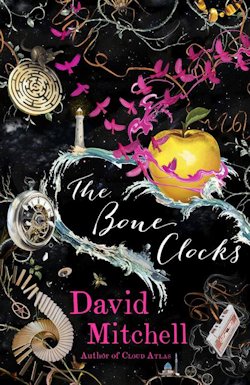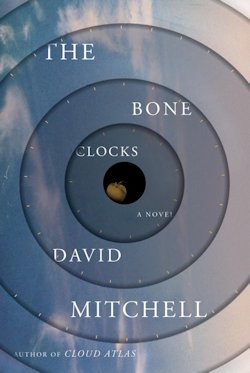An exquisite exploration of the beauty and the tragedy of mortality, The Bone Clocks is a soaring supernatural sextet split into sections carefully arranged around the novel’s initial narrator.
A baby-faced runaway when we meet in the mid-eighties, Holly Sykes has become a wistful old woman by the book’s conclusion in the year 2043. Between times David Mitchell depicts her diversely: as a friend and a lover; a wife and a mother; a victim and a survivor; and more, of course, as the decades prance past. The Bone Clocks is, in short, the story of Holly Sykes’ life: a life less ordinary that leads her—as if by the whims of some Script—into the midst of a macabre conflict between eternal enemies fought in the farthest fringes of existence.
But that doesn’t happen until the last act. In the beginning, Holly is no more and no less than a normal girl in a normal world with normal problems—like the backstabbing boyfriend she left the nest to take up with. Too proud to crawl back to her family after a screaming match with her Mam, Holly hightails it as far away from home as her aching feet can take her—pretty much to prove a point:
Six days should do it. The police only get interested in missing teenagers once a week’s up. Six days’ll show Mam I can look after myself in the big bad world. I’ll be in a stronger, whatchercallit, a stronger negotiating position. And I’ll do it on my own, without a Brubeck to get all boyfriendish on me.
Even as a teenager, Holly’s pretty together, so she manages to make ends meet in the interim. Furthermore, she finds a few ways to extend her experimental independence… if not indefinitely, since the Script we learn about later has other plans for our protagonist.
Sometimes, you see, “the gears of what’s real [seem to] slip,” to wit, whilst walking, Holly encounters a crazy old lady who seeks asylum in her subconscious; glimpses a woman “with white-blonde hair and bone-pale skin, rich rose-red lips and a midnight-blue ball-gown” through a window which isn’t; and escapes the scene of an impossible slaughter thanks entirely to the assistance of… a spirit?
Holly doesn’t remember this last, alas. Her life would have charted a rather different path if she had. Instead, her week on the wild side comes to a sudden stop when she hears of her little brother’s mysterious disappearance.
This tragedy marks the end of A Hot Spell, which is the first book of The Bone Clocks. In the next—namely Myrrh Is Mine, Its Bitter Perfume—another narrator takes the reins. All of a sudden it’s 1991, and Holly is gone… if not for long. Cambridge con-artist Hugo Lamb may be “a master dissembler,” but even he realises that the time will come when he’s caught. In advance of that, though, he falls for a woman in whom he might, at last, have met his match:
This isn’t lust. Lust wants, does the obvious, and pads back into the forest. Love is greedier. Love wants round-the-clock care; protection; rings, vows, joint accounts; scented candles on birthdays, life insurance. Babies. Love’s a dictator. I know this, yet the blast furnace in my rib-cage roars You You You You You You just the same, and there’s bugger all I can do about it.
The object of Hugo’s unexpected affection is Holly, obviously… and we encounter her again in the next section—The Wedding Bash—as the other half of Ed Brubeck, to whom we were introduced earlier. In 2004 he’s a prize-winning reporter, recently returned to his wife and child after many months on assignment in the Middle East. Unlike Hugo, Ed’s a good man from the ground up, but he finds his marriage on the rocks regardless. Why? Because he wants—indeed he needs—to go back to Iraq, and Holly isn’t having that.

Needless to say, not all of our narrators are such decent people. Hugo’s a horror who gets away with more than he might because of his whip-smart wit; Crispin Hershey, however—British publishing’s pet prick—is almost wholly hateable. This is a man who fantasises about his ex-wife and children being killed in a car crash so as to seem more sympathetic to a beautiful woman who’d be out of his league otherwise. I dare say he does soften somewhat as the years pass, but let’s not bugger about: Hershey is an absolute ass.
Next up, in the 2020s, another nice guy. It falls to an Horologist called Marinus to convince a fifty-odd Holly that “the impossible is negotiable.” If he can’t get through to her, the war against the Anchorites of the Chapel of the Dusk of the Blind Cathar (and breathe) is all but lost. “Every year, we save a few,” Marinus bemoans, but “Horology’s drifting towards irrelevance. There aren’t enough of us. Our networks are fraying.” Holly’s help, however, might just turn the tide.
A master of incidental detail and the quirks of consciousness that transform collections of characteristics into actual characters, Mitchell makes every one of the aforementioned men incredibly compelling, allowing us striking insight into the minds of monsters—minds more like our own than we might like—and good human beings both. So no, not all of The Bone Clocks’ narrators are pleasant people, but they read as real—as do the worlds they inhabit, whether these worlds once were or are the stuff of science fiction—and that’s what matters.
Holly, for her part, is a very different grandma than she is a kid, but every last iteration of her, however dissimilar to the preceding or succeeding depiction it is, builds towards a bigger, more particular portrait of her personality. She’s the single most substantial character I’ve come across since Vic McQueen in NOS4A2, to which book The Bone Clocks as a whole bears a certain resemblance; also Angelmaker, Doctor Sleep, and the author’s own award-winner, Cloud Atlas.
The Bone Clocks is not necessarily as grand and bombastic as that last, but it is intimate, and ambitious—and, by the by, brilliant. Your mileage may vary—both novels number amongst the best British fiction there is—but I certainly preferred the clarity of The Bone Clocks’ conscientiously crafted characters and neatly interweaving narratives to the admittedly awesome cacophony of Cloud Atlas.
It’s an extraordinary story, all told, yet it isn’t perfect—and, sadly from a speculative standpoint, Mitchell’s missteps are especially evident in the section intended to address the plot’s fantastical flourishes. It simply isn’t the sweet release it needs to be. Fans of the form, in fact, are likely to find the territory it treads—or rather retreads—tedious, and the burdensome worldbuilding that makes An Horologist’s Labyrinth the biggest of The Bone Clocks’ six bits is at best haphazardly handled.
The rest of the text is so superlative that these over-scripted sequences are small potatoes in the scheme of things, though. Only time will tell whether The Bone Clocks is the best book of the year, but I do believe it could be the crowning glory of David Mitchell’s career.
![]() The Bone Clocks is available now from Random House.
The Bone Clocks is available now from Random House.
Niall Alexander is an extra-curricular English teacher who reads and writes about all things weird and wonderful for The Speculative Scotsman, Strange Horizons, and Tor.com. He’s been known to tweet, twoo.










